CS-Cart and Multi-Vendor 4.3.6 Are Here!
Version 4.3.6 got a performance boost and new Multi-Vendor features, including the anticipated vendor subscription plans
Hello!
We’re proudly bringing to you the new version of our shopping platform—CS-Cart and Multi-Vendor 4.3.6.

Although this is a minor release that fixes bugs, it also brings new features and PHP 7 support, which speeds up your store and makes it more enduring:
-
- PHP 7 support—CS-Cart 4.3.6 works with PHP 7, which speeds up page loading and allows CS-Cart to withstand a higher load.
-
- Store import is back—upgrade from version 2.2.4 and higher to the latest version by importing all of your store data to CS-Cart 4.3.6 installation while keeping your current store up and running.
-
- Сhanges to enhance usability of your store—links for quick accessing a carrier’s parcel-tracking page from the admin panel, correct displaying of the delivery period for UPS, the Subcategories tree filling for the categories block, and the Description field for shipping methods.
-
- Vendor plans add-on (beta)—create subscription plans for vendors with restrictions, such as maximum number of vendor products, maximum revenue per month, and more.
-
- Vendor’s terms and conditions add-on—allow your vendors to add their terms and conditions that customers must accept at checkout.
-
- No empty categories in a vendor microstore—if a vendor doesn’t use one of the available categories, this empty category is not displayed in his or her microstore.
- A vendor can get the Pending status more than once—a marketplace admin can change a vendor’s status from Active to Pending at the vendor’s request.
See other changes in the changelog.
Performance Boost
Speed and stamina are important for a website. Make a visitor wait too long for the page to load—he leaves. Make a visitor see your store crashes—he never returns. Good performance is especially critical for an online store because when a visitor leaves your store, you lose a potential customer and money.
CS-Сart 4.3.6 speeds up your store and enables it to withstand a higher load on PHP 7—it’s confirmed as the fastest version of PHP, it even beats HHVM.
We’ve taken the cheapest 5-dollar VPS hosting on DigitalOcean and compared the performance of CS-Cart 4.3.6 on PHP 7 and PHP 5.6 to one of the most popular CMS—WordPress.
WordPress is known for its simplicity and light functionality. CS-Cart, which has a richer set of ecommerce features, shows superiority in performance tests:
-
- If the number of HTTP requests exceeds the number a store can handle per second, it slows down and crashes. CS-Cart 4.3.6 on PHP 7 handles 2 times more HTTP-requests per second than WordPress:
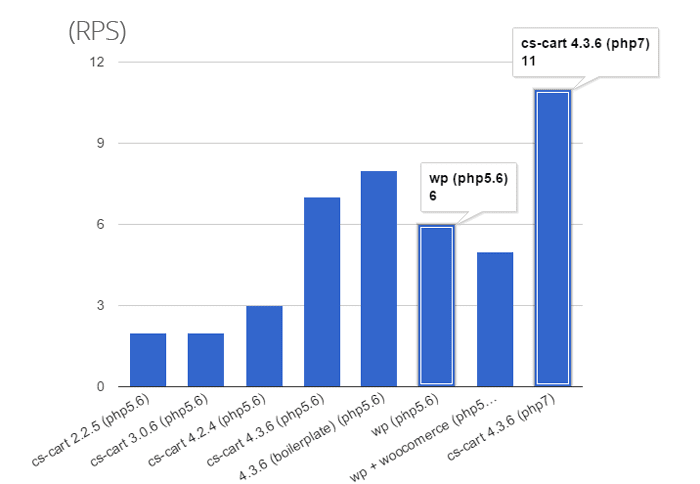
- If the number of HTTP requests exceeds the number a store can handle per second, it slows down and crashes. CS-Cart 4.3.6 on PHP 7 handles 2 times more HTTP-requests per second than WordPress:
- The faster a page starts loading, the sooner a customer sees the page. Pages in CS-Cart 4.3.6 start loading sooner than in WordPress:
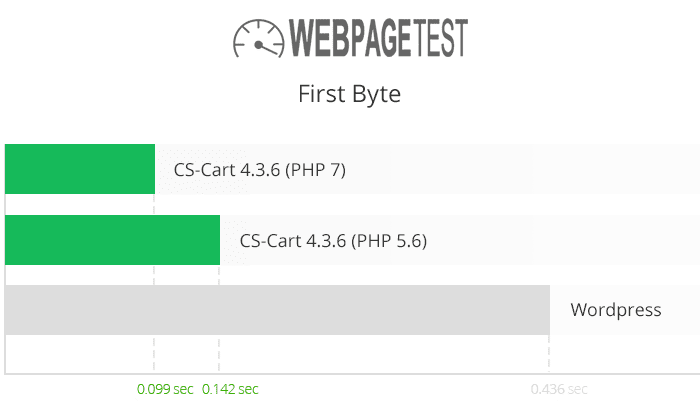
Store Import
It’s important to keep your store software up to date to ensure security, speed, and feature richness. But moving to the new CS-Cart version could be a painful procedure sometimes—upgrading can cause issues on some servers or if your store is deeply modified.
Now, here comes Store Import. Simply transfer all of your store’s data to the new CS-Cart installation, keeping your current store online. First, if something is not working after the import, you still have your old store up and running. Second, you continue selling in your old store while configuring the new one after the successful import.
You can import your store data from CS-Cart 2.2.4 and higher, both Professional and Ultimate.
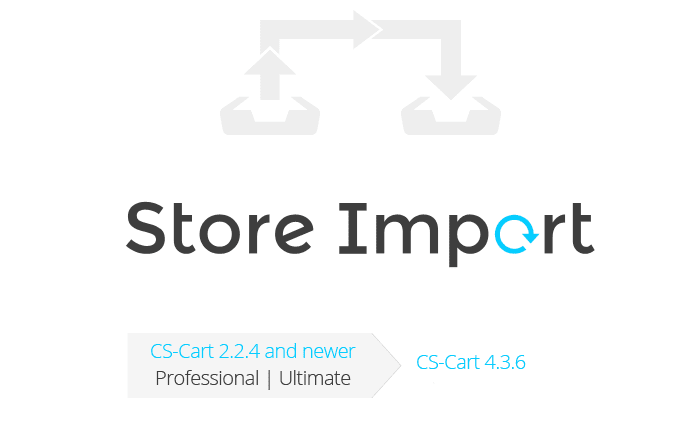
Changes to Enhance Usability
To make CS-Cart clearer and easier to use, we’ve added links to tracking numbers so you can quickly access a carrier’s parcel-tracking page from the admin panel, made the UPS delivery period look clearer, and included the new Subcategories tree display style of categories:
-
- Links for quick accessing a carrier’s parcel-tracking page from an order details page—click a tracking number on an order details page to open the carrier’s tracking page and check the delivery status of the order. This feature saves you time because you don’t have to copy the tracking number and insert it manually onto the carrier’s tracking page.
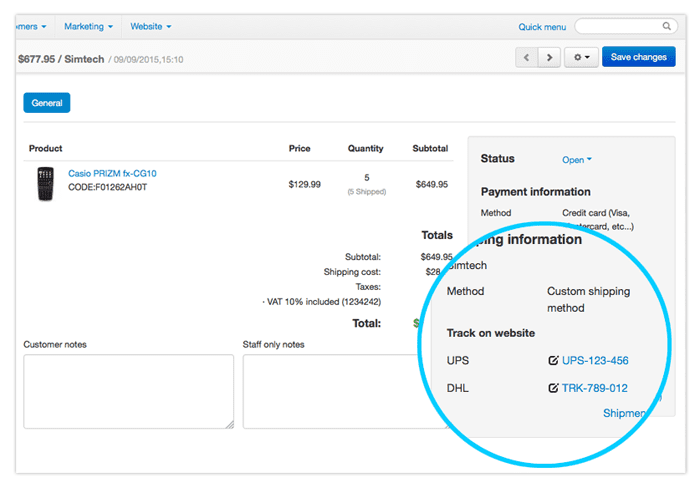
- Links for quick accessing a carrier’s parcel-tracking page from an order details page—click a tracking number on an order details page to open the carrier’s tracking page and check the delivery status of the order. This feature saves you time because you don’t have to copy the tracking number and insert it manually onto the carrier’s tracking page.
-
- Clear delivery period for UPS—when UPS returns the delivery period in days to your store, a customer sees a clear delivery period in days: ‘3 days’ for example. In earlier versions, a customer saw only ‘3’ without the ‘days’, which was confusing.
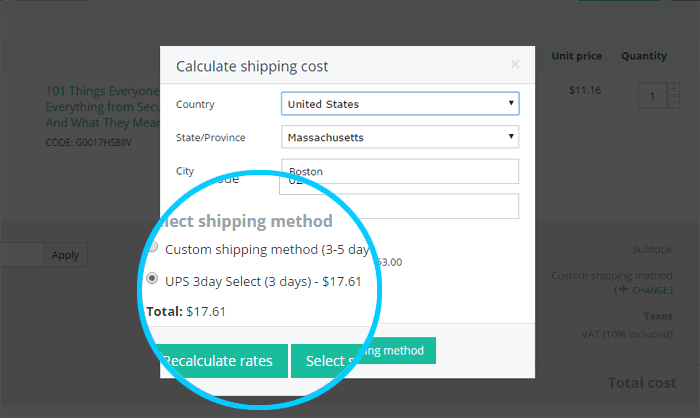
- Clear delivery period for UPS—when UPS returns the delivery period in days to your store, a customer sees a clear delivery period in days: ‘3 days’ for example. In earlier versions, a customer saw only ‘3’ without the ‘days’, which was confusing.
-
- Subcategory filling for the categories block—on a category page, customers only see subcategories of that category, not the full category tree.
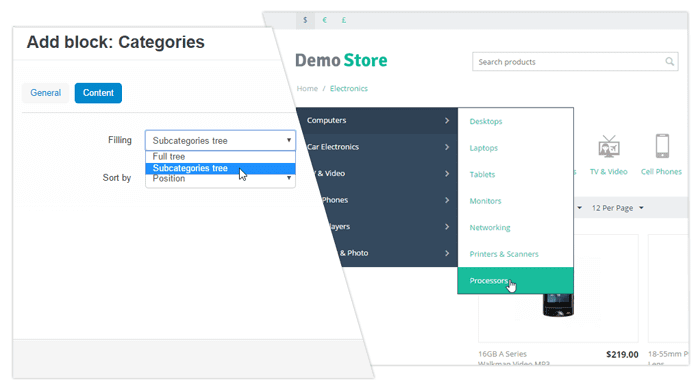
- Subcategory filling for the categories block—on a category page, customers only see subcategories of that category, not the full category tree.
- The Description field for shipping methods—on a shipping editing page, you can enter descriptions for shipping methods, that customers will see at checkout:

Vendor Subscription Plans (Multi-Vendor)
Multi-Vendor 4.3.6 supports an anticipated feature—Vendor plans that allows a marketplace admin to create subscription plans for the vendors.
We haven’t yet included the Vendor plans add-on in the Multi-Vendor 4.3.6 installation package because we’re going to be testing the add-on and putting the finishing touches according to your suggestions.
Keep an eye on our forum so as not to miss the post about Vendor plans containing installation and configuration instructions.
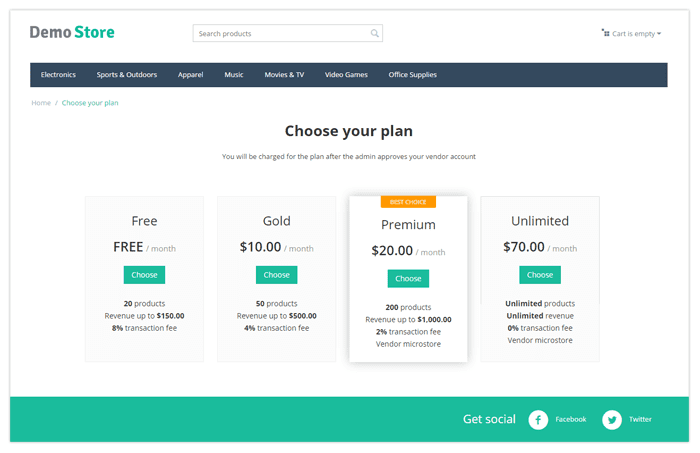
The Vendor plans add-on is a flexible tool that helps you increase your revenue if used wisely:
-
- Create as many plans as you want, edit, and delete them all on the Vendor → Vendor plans page.
- Set the plan’s price, the period for which a vendor pays for the plan, and the transaction fee that you will charge for each order.
-
- Define the maximum number of products a vendor can have, set the maximum revenue per month a vendor can get, and allow or disallow a vendor to have a microstore with filters, categories, and search.
-
- Allow your vendors to access only particular categories and assign plans to existing vendors.
- Vendors monitor the usage of the plans on their dashboards and change plans themselves.
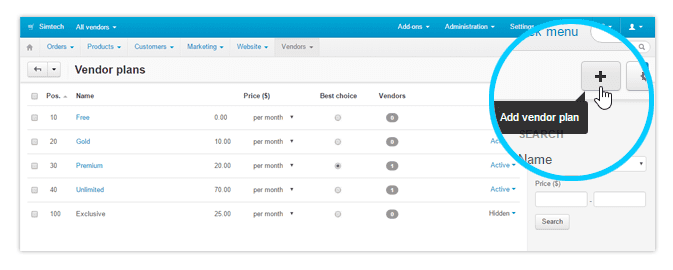
Vendor’s Terms and Conditions (Multi-Vendor)
The Vendor’s terms and conditions add-on in Multi-Vendor 4.3.6 allows vendors to specify their terms and conditions so that the customers accept them at checkout.
Terms and conditions act as a legal contract between a vendor and a customer. It’s important for a vendor to have his/her own terms and conditions—this will demarcate liability between the marketplace owner and the vendor, and help to handle conflicts between a customer and a vendor.
A vendor specifies the terms and conditions on the vendor editing page in Vendor → Vendors:
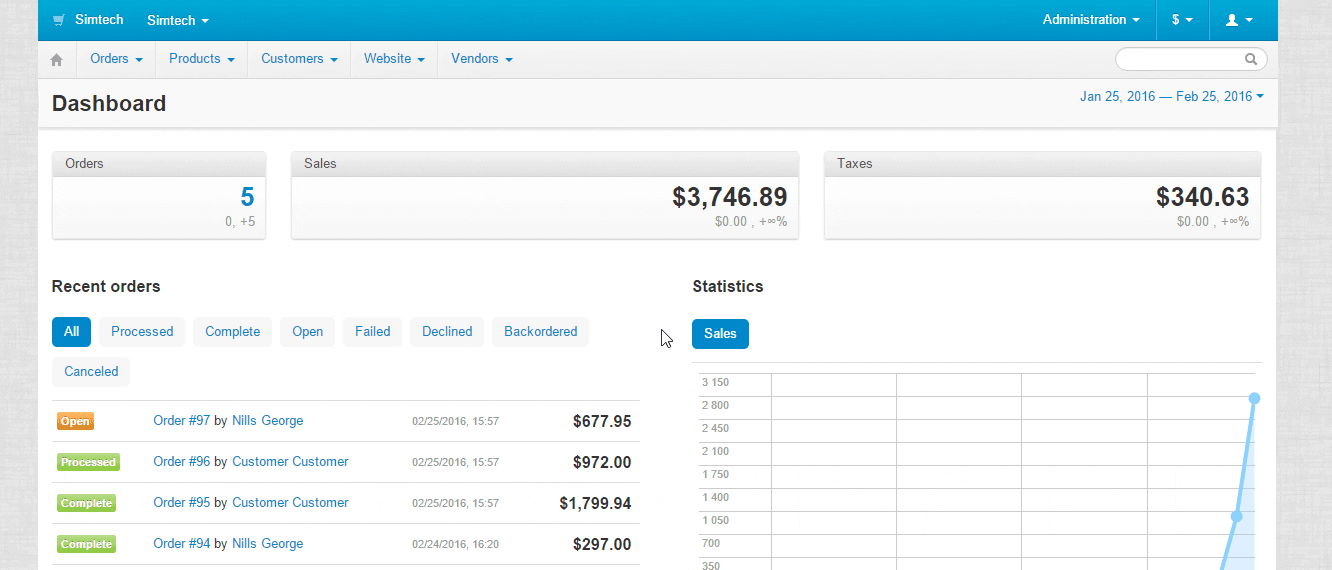
At checkout, customers must accept the terms and conditions of each vendor, whose products they are buying:
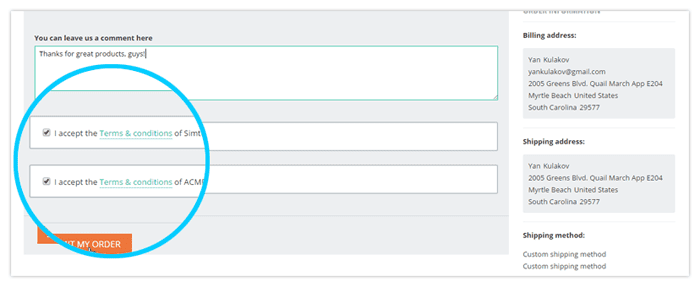
No Empty Categories in Vendor’s Microstore (Multi-Vendor)
On a Multi-Vendor marketplace, vendors can have their own microstores with filters, search by vendor’s products, and categories.
Marketplace admins often allow vendors to use all the categories available in their marketplaces, but vendors usually do not use all of them. In the previous Multi-Vendor versions, unused categories were displayed in a vendor’s microstore, and customers could view those empty categories. As a result, customers could get confused.
In Multi-Vendor 4.3.6, empty categories vendors don’t use are not displayed in a vendor’s microstore.

Pending Status for Vendor More Than Once (Multi-Vendor)
A marketplace admin must approve new vendors before they can sell. If an admin is unsure whether to approve a vendor or not, he sets the vendor’s status to Pending. In the Pending status, a vendor can access his admin panel, change the company information, and add products.
In earlier Multi-Vendor versions, an admin could set the Pending status only once—right after the vendor completed registration.
If an active vendor is reorganizing his business, or moving all his supplies to a new warehouse, he needs to suspend selling. The Pending status is the best option for that—the vendor still can manage the microstore, but customers don’t see this vendor’s products in the marketplace.
In Multi-Vendor 4.3.6, an active vendor can ask the marketplace admin to change his status to Pending at any time.
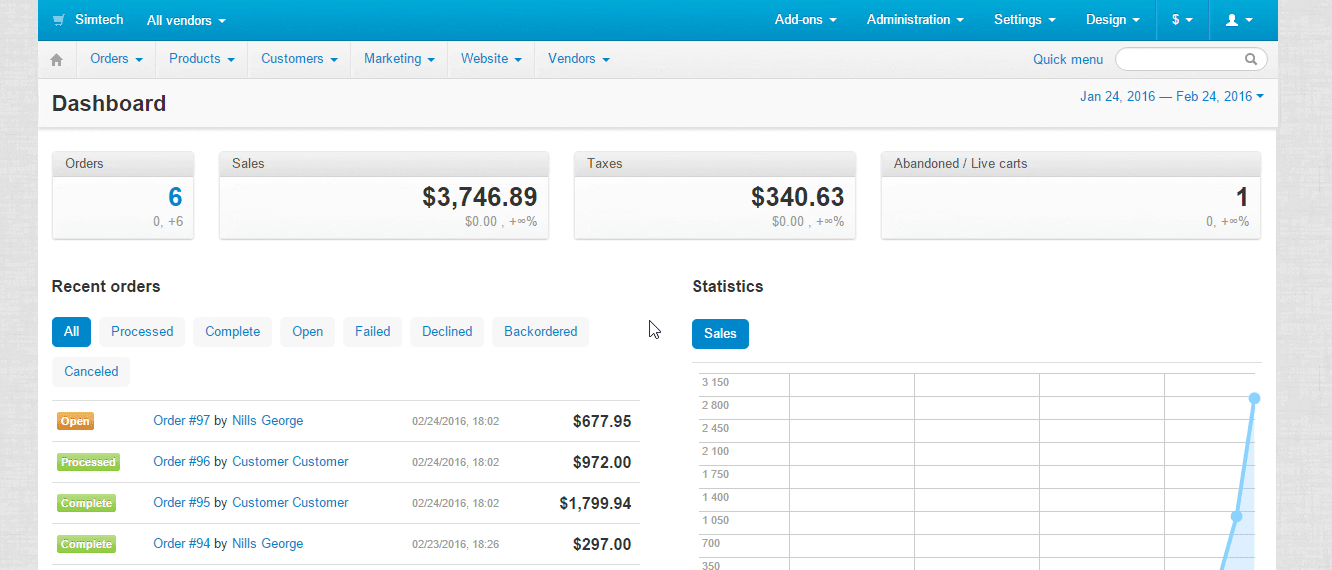
Get It
Before upgrading to CS-Cart 4.3.6, make sure that your server has PHP 5.3.6 or newer—older PHP versions are no longer supported.
You have 2 options to upgrade to CS-Cart 4.3.6:
-
- Via the Upgrade center on the Administration → Upgrade center page of your admin panel. License owners with active upgrade subscriptions will see the available upgrade in their Upgrade centers within a week.
- Via Store Import on the Add-ons → Store Import page (make sure you have the Store Import add-on installed). All you need is to download the CS-Cart 4.3.6 installation package and install it on your server. Then import your current store’s data to the new CS-Cart installation.
If you’ve never used CS-Cart before, download the installation package and buy a license.
We hope that you like the new version. We greatly appreciate your ideas on how to make CS-Cart even better. Share your thoughts on our Uservoice.
Please report bugs to our bug tracker.
If you have any questions about the new features or the upgrade, feel free to ask them here in the comments or in the CS-Cart Forums.
Follow CS-Cart on Facebook and Twitter to keep in touch with the latest CS-Cart news.
Subscribe to our newsletters via the form below to receive news and storefront design ideas directly to your mailbox.
Follow CS-Cart news & promotions
Yan Anderson is the Head of Content Marketing at CS-Cart with over 10 years of experience in the eCommerce industry. He's passionate about explaining complicated things in simple terms. Yan has expertise in building, running and growing eCommerce marketplaces. He loves to educate people about best practices, new technologies, and trends in the global eCommerce industry.
